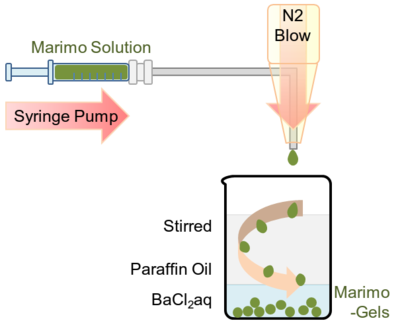"Results": Difference between revisions
Shizuka Anan (talk | contribs) (New page: <div style="padding: 10px; width: 730px; color: #3ca83c; background-color:#3ca83c"> 150px &nb...) |
Shizuka Anan (talk | contribs) No edit summary |
||
| Line 20: | Line 20: | ||
[["Sponsors" | <font face="trebuchet ms" style="color:#FFFFFF" size="4">'''Sponsors''' </font>]] | [["Sponsors" | <font face="trebuchet ms" style="color:#FFFFFF" size="4">'''Sponsors''' </font>]] | ||
</div> | </div> | ||
[[Image:大見出し.png|30 px]]<font size="5">Experiment 1[[Image:大見出し.png|30 px]] Preparation of Ring-shaped microtubule assemblies</font> | |||
To obtain ring-shaped microtubules, we perform dynamic self-assembly on kinesin-coated glass surface. <br> | |||
Under an appropriate concentration of each solutions (200 nM kinesin, 5 microM microtubule (60 % biotinilated),<br> | |||
300 nM streptavidin, 5 mM ATP ), rotating ring-shaped microtubules were successfully formed (Fig. 1-1).<br> | |||
[[Image:Rimgs.jpg| 500 px]]<br> | |||
<font size="4">Fig. 1-1 Fluorescent image of ring-shaped microtubule formed on kinesin-coated surface.</font><br> | |||
<br> | |||
To understand the properties of the ring-shaped microtubules, we measure their diameter and velocity of rotation. <br> | |||
Histograms based on each results were prepared and showed below (Fig. 1-2 ,1-3).<br> | |||
<font size="4"> | |||
[[Image:Diameter.png| 400px]] | |||
<br>Fig. 1-2 Histogram of the diameter of ring-shaped microtubules. <br> | |||
<br><br> | |||
[[Image:Velocity.png| 500px]] | |||
<br>Fig. 1-3 Histogram of the velocity of rotation.<br> | |||
</font> | |||
The size and the velocity of ring-shaped microtubule assemblies were stable and good enough to continue our experiments. <br> | |||
---- | |||
[[Image:大見出し.png|30 px]]<font size="5">Experiment 2 [[Image:大見出し.png|30 px]]Preparation of Marimo-gel</font> | |||
<br>This experiment was performed by following the method on “materials” page.<br> | |||
<font size="4"> | |||
[[Image:marimogel.png|400px]]<br> | |||
Fig. 2-1 Schematic illustration of preparing Marimo-gel.<br><br> | |||
[[Image:marimo-gel.png|400px]]<br> | |||
Fig. 2-2 Micrograph of Marimo-gel prepared in this experiment.<br><br> | |||
[[image:Histogram_of_diameter_of_marimo.png|400px]]<br> | |||
Fig. 2-3 Histogram of diameter of Marimo-gel.<br><br> | |||
</font> | |||
<p> | |||
Marimo-Gel obtained in this experiment is very much larger than we expected. The diameter should be around several tens <br> | |||
micrometers size to introduce into the flowcell where the ring-shaped microtubules were formed. Also the shape of Marime-gel <br> | |||
was not a good globule.<br> | |||
To prepare smaller and spherical Marimo-gel, we are planning to try another method. By using an appropriate surfactant, <br> | |||
o/w emulsion system seems to us is suitable to prepare micro-Marimo-Gel.<br> | |||
</p> | |||
[[Image:大見出し.png|30 px]]<font size="5">Experiments3 [[Image:大見出し.png|30 px]]Preparation of micro-sized gear</font><br> | |||
To obtain micrometer-sized gear, we perform lift-off methods for MEMS devices.<br> | |||
[[Image:20130829_145254.jpg| 500px]] | |||
[[Image:20130829 151351.jpg|500 px]]<br> | |||
<font size="4">Fig. 3-1 Micro-sized gear prepared by lift off method.<br><br> | |||
</font><br> | |||
We successfully prepare the micrometer-sized gear. | |||
Latest revision as of 10:12, 31 August 2013
![]() Experiment 1
Experiment 1![]() Preparation of Ring-shaped microtubule assemblies
Preparation of Ring-shaped microtubule assemblies
To obtain ring-shaped microtubules, we perform dynamic self-assembly on kinesin-coated glass surface.
Under an appropriate concentration of each solutions (200 nM kinesin, 5 microM microtubule (60 % biotinilated),
300 nM streptavidin, 5 mM ATP ), rotating ring-shaped microtubules were successfully formed (Fig. 1-1).

Fig. 1-1 Fluorescent image of ring-shaped microtubule formed on kinesin-coated surface.
To understand the properties of the ring-shaped microtubules, we measure their diameter and velocity of rotation.
Histograms based on each results were prepared and showed below (Fig. 1-2 ,1-3).

Fig. 1-2 Histogram of the diameter of ring-shaped microtubules.

Fig. 1-3 Histogram of the velocity of rotation.
The size and the velocity of ring-shaped microtubule assemblies were stable and good enough to continue our experiments.
![]() Experiment 2
Experiment 2 ![]() Preparation of Marimo-gel
Preparation of Marimo-gel
This experiment was performed by following the method on “materials” page.

Fig. 2-1 Schematic illustration of preparing Marimo-gel.

Fig. 2-2 Micrograph of Marimo-gel prepared in this experiment.

Fig. 2-3 Histogram of diameter of Marimo-gel.
Marimo-Gel obtained in this experiment is very much larger than we expected. The diameter should be around several tens
micrometers size to introduce into the flowcell where the ring-shaped microtubules were formed. Also the shape of Marime-gel
was not a good globule.
To prepare smaller and spherical Marimo-gel, we are planning to try another method. By using an appropriate surfactant,
o/w emulsion system seems to us is suitable to prepare micro-Marimo-Gel.
![]() Experiments3
Experiments3 ![]() Preparation of micro-sized gear
Preparation of micro-sized gear
To obtain micrometer-sized gear, we perform lift-off methods for MEMS devices.


Fig. 3-1 Micro-sized gear prepared by lift off method.
We successfully prepare the micrometer-sized gear.
